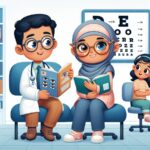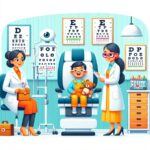Nystagmus, a condition characterized by involuntary eye movements, can be a concerning observation for new parents. Understanding this condition’s intricacies is crucial for providing the best care and support for your child. This comprehensive guide delves into what nystagmus is, its causes, symptoms, and the available treatment options, offering valuable insights to parents navigating this challenge.
What is Nystagmus?
Nystagmus involves rapid, uncontrollable eye movements, which can be horizontal, vertical, or rotational. This condition may affect one or both eyes and can lead to issues with vision clarity and depth perception. While it might be alarming to witness, understanding nystagmus is the first step toward helping your child.
There are various forms of nystagmus, each with its own set of causes and implications. Congenital nystagmus, which is present at birth or develops shortly after, is often linked to genetic factors. Acquired nystagmus, on the other hand, can result from underlying health issues or injuries.
Causes and Risk Factors of Nystagmus
The causes of nystagmus can range from genetic predispositions to complications during pregnancy or early childhood. Some children with nystagmus might also have other conditions, such as albinism or optic nerve hypoplasia, which can contribute to the development of nystagmus.
Environmental factors and lifestyle choices during pregnancy, like substance abuse, can also increase the risk of a baby developing nystagmus. Additionally, conditions like brain injury or diseases that affect the central nervous system can lead to acquired nystagmus later in life.
Diagnosing Nystagmus in Babies
Early diagnosis of nystagmus is crucial for effective management and treatment. Pediatricians or pediatric ophthalmologists usually detect nystagmus through a comprehensive eye examination. This may include observing the child’s eye movements and conducting tests to assess vision and eye health.
Advanced imaging techniques, such as MRI or CT scans, can be utilized to identify any underlying conditions contributing to nystagmus. Early intervention programs and support groups can also be beneficial for families, providing resources and coping strategies.
Treatment Options for Nystagmus
While there is no cure for nystagmus, several treatment options can help manage the condition and improve the quality of life for affected children. In some cases, corrective eyewear or contact lenses can enhance vision. Surgical procedures might also be considered to adjust the position of the eyes, reducing the severity of the nystagmus.
Therapies focused on visual rehabilitation and the use of assistive devices can also play a significant role in supporting a child’s development. Regular follow-ups with eye care professionals are essential to monitor the condition and make adjustments to the treatment plan as needed.
Supporting Your Child with Nystagmus
Having a child with nystagmus can be challenging, but with the right support and resources, families can navigate this journey effectively. Engaging in communities and support groups can provide emotional support and practical advice. Educational resources, such as those offered by the Nystagmus Network, can be invaluable.
It’s also important to advocate for your child’s needs, ensuring they receive appropriate accommodations at school and in other settings. Creating a nurturing and understanding environment at home is crucial for your child’s confidence and development.
Understanding nystagmus and its implications is vital for new parents facing this diagnosis. By arming yourself with knowledge, seeking the right medical support, and providing a supportive home environment, you can help your child thrive despite the challenges of nystagmus.













